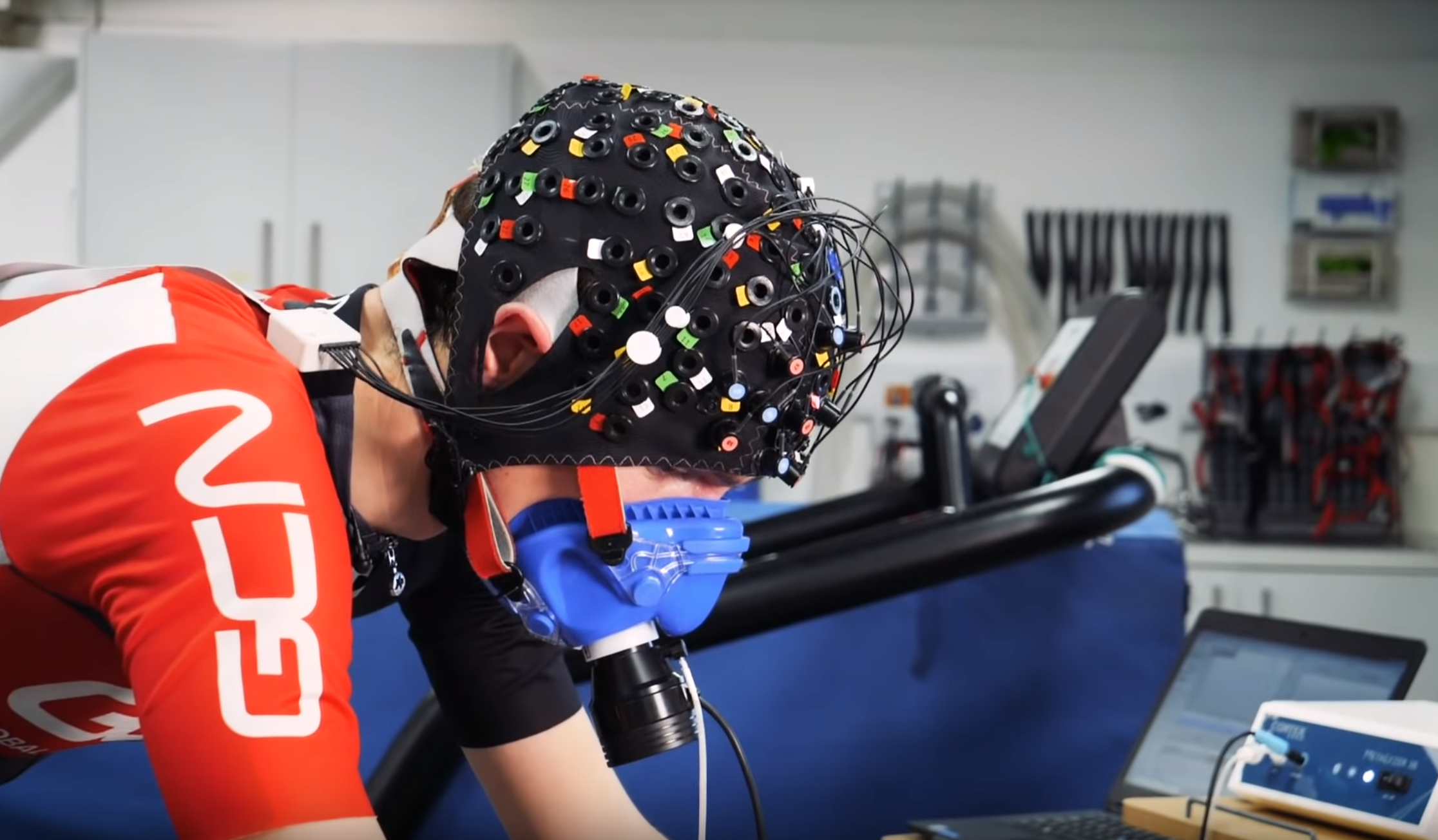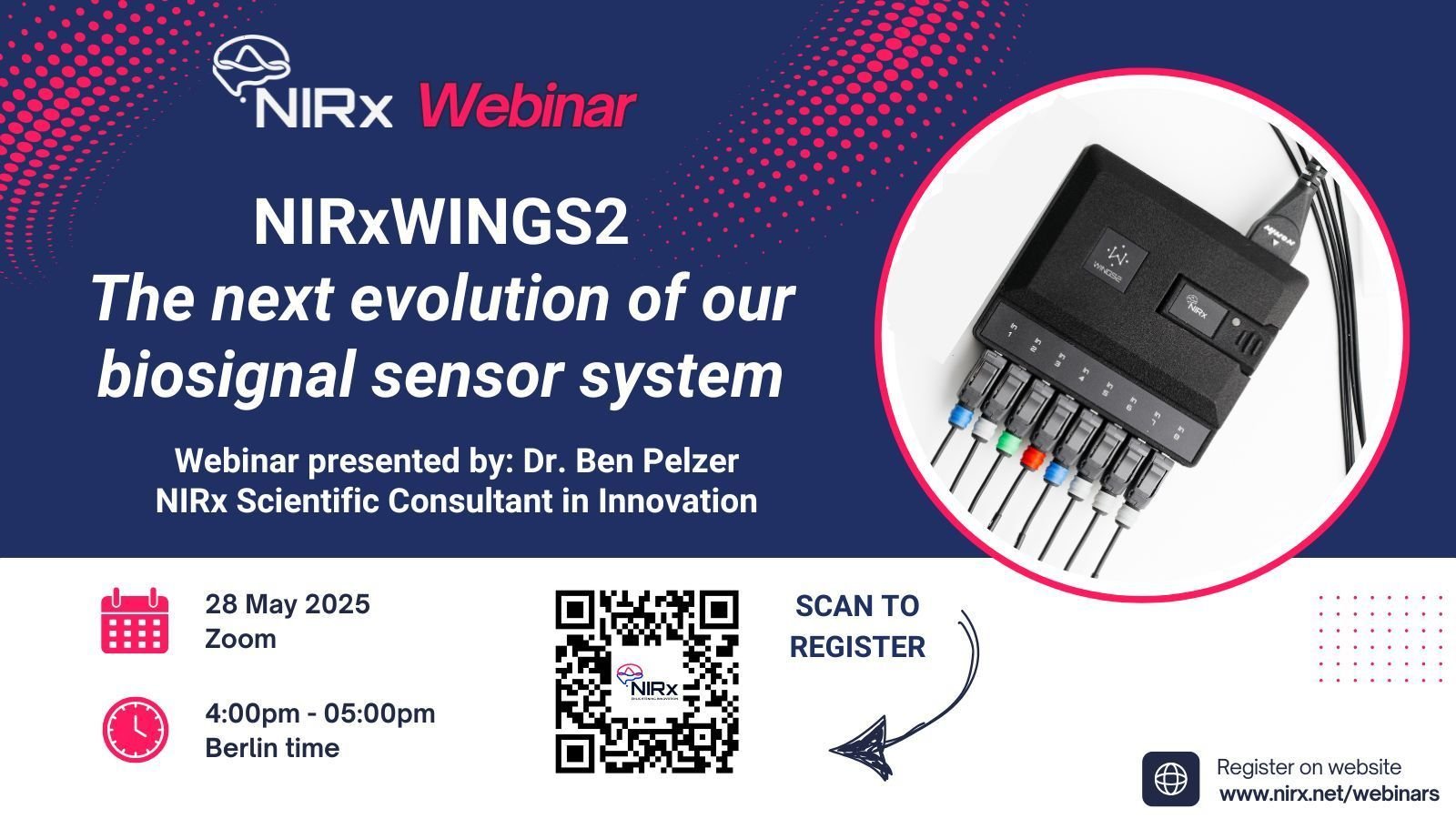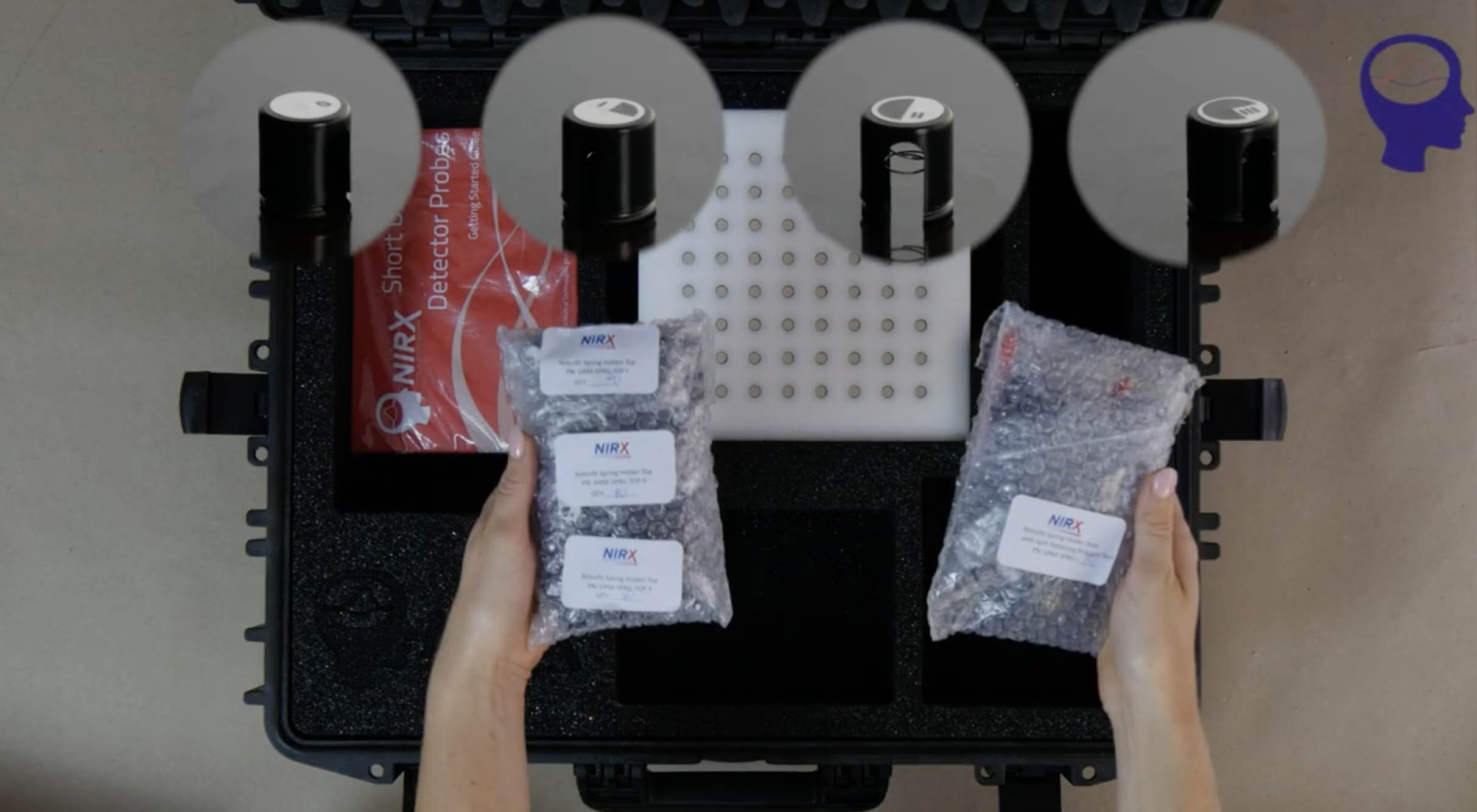Functional Near Infrared Spectroscopy (fNIRS) is a flexible and non-invasive imaging technique, making it particularly attractive for studies in naturalistic, mobile, and social environments. One of the major advantages of fNIRS is the ease with which it can be combined with other modalities such as peripheral physiology. Indeed, recent progress in fNIRS methods has identified two ways that physiological data can be incorporated into fNIRS analyses.
First, fNIRS is designed to measure the cerebral hemodynamic responses evoked by neural activity. However, as the technique measures light absorption through both cerebral and extracerebral tissues, systemic physiological processes, such as cardiac pulsation, respiration, and autonomic fluctuations, can significantly contaminate the signal (Figure 1). Addressing these confounds is therefore critical for accurate interpretation.
Figure 1: A graphic of the physiological signals reaching the detector and their origins. Functional brain activity comes from the cerebral cortex, but respiration, cardiac, and Mayer wave data reaching the detector come from both the cerebral and extracerebral layers. Sensors measuring systemic signals in the body, such as EMG, respiration, and short-distance detectors, can help remove those artefacts.
The second application of combined fNIRS-peripheral physiology integrates both in order to investigate the brain-body relationships by examining how peripheral physiology interacts with neural responses (joint analysis).
This dual motivation, cleaner data and richer insights, has led to growing interest in what is now termed Systemic Physiology-Augmented fNIRS (SPA-fNIRS) (Scholkmann et al., 2022). The following sections discuss the nature of these physiological confounds, the methods used to address them, examples of SPA-fNIRS in recent publications, and how the NIRxWINGS2 system facilitates both robust denoising and advanced multimodal research paradigms.
SPA-fNIRS for Denoising
fNIRS captures light absorption through tissue, and that means it also picks up non-neural signals from the scalp, skin, and superficial vasculature. As Tachtsidis and Scholkmann (2016) explain, these systemic influences can introduce false positives or negatives, distorting experimental results (Figure 2). Even subtle changes in heart rate variability or respiration can shift the fNIRS baseline, mimicking brain activation or obscuring it entirely.
Figure 2: Visualization of the six components of the fNIRS signals. (a) An incorrect assumption is that the fNIRS signal represents only changes associated with functional brain activity due to neurovascular coupling. (b) In reality, the fNIRS signals comprise six components, so that five components are potentially confounders in every fNIRS study. The contribution of the components to the fNIRS signal is visualized by color-coding (red: 100%, white: 0%). As the figure shows, four of these five potential confounds relate to systemic signals of the sort measured by the NIRxWINGS2. From Tachtsidis and Scholkmann (2016).
Peripheral Signals vs Short Channels
To combat this issue, physiological signals can be measured concurrently and used to model and regress out non-neural variance (Figure 3). In fNIRS, there are two primary approaches to measuring systemic influences: short-distance detectors capture extracerebral systemic signals (see our webpage on short distance detectors) but by definition do not measure from the cerebral compartment, while dedicated peripheral physiology sensors directly measure specific physiological modalities, potentially allowing for the removal of cerebral and extracerebral systemic signals. Indeed, these approaches are complementary and can in principle be combined. This integration leads to cleaner fNIRS data.
As von Lühmann et al. (2020) demonstrated using advanced signal separation methods, adding peripheral signals alongside short channels led to improvements of 12–16% across a set of data quality metrics. Likewise, Gugliemini et al. (2025) showed that the impact of changes in breathing was not fully captured by short-channel data, but could be accounted for with additional peripheral signals.
However, collecting and synchronizing these signals has historically been a technical hurdle.
NIRxWINGS2: Seamless Systemic Physiology Integration
NIRxWINGS2 is NIRx Medical Technologies’ dedicated module for capturing peripheral physiological data alongside fNIRS. Designed as an extension for the NIRSport2 system, NIRxWINGS2 empowers researchers to conduct SPA-fNIRS with minimal setup complexity.
Figure 3: NIRxWINGS2 wearer equipped with respiration belt, bipolar EMG sensors, PPG, GSR, temperature sensor, and two NIRSport2s with 32x32 source-detector montage. (NIRx, 2025)
What NIRxWINGS2 Measures
Respiration – Chest expansion and breathing rhythm
Electrodermal Activity (EDA/GSR) – Sympathetic arousal
Skin Temperature – Peripheral vasodilation/constriction
Pulse Oximetry (PPG) – Heart rate and SpO₂
Bipolar signals such as EMG and ECG – Muscle and cardiac activity
All data streams—including triggers— are fully synchronized within the NIRx Aurora software, eliminating the traditional headaches of integrating multiple systems. Wireless data transmission and onboard storage allow participants to move freely, even outside the lab, while still capturing high-quality multimodal datasets.
SPA-fNIRS Enriches fNIRS Experiments
Figure 4: Participant in the Li et al. 2024 study on developing a human-machine trust evaluation method for High-Speed Train Drivers
Recent research demonstrates the power of Systemic Physiology-Augmented fNIRS (SPA-fNIRS) to capture complex interactions between brain activity and peripheral physiological signals.
Examples of Recent SPA-fNIRS Research
Li et al. (2024) developed a trust evaluation method for high-speed train drivers using multimodal physiological signals to enhance human-machine interaction safety.
Khazaei et al. (2024) describe a rich multimodal dataset of ECG, respiration, skin surface temperature, skin conductance (EDA), PPG, EMG, and facial expressions with fNIRS to investigate working memory under music stimulation.
Guglielmini et al. (20222025) used SPA-fNIRS to track hemodynamics, peripheral physiology, and the interplay between the two during a social interaction task.
Peng et al. (2024) explored how real-time physiological metrics can inform pain monitoring under anesthesia using advanced fNIRS modules.
Wu et al. (2024) examined neuromuscular control post-exercise cold water immersion on neuromuscular control through integrated neuroimaging and EMG.
Sheng et al (2025) integrated surface EMG and fNIRS data to investigate the effectiveness of walking-conversion training in a clinical trial with stroke patients.
Angioletti et al. (2025) demonstrated how brain activity and peripheral autonomic responses work synergistically during persuasion in shared decision-making contexts in a hyperscanning study.
The NIRxWINGS2 system can facilitate these approaches by seamlessly synchronizing peripheral signals such as respiration, electrodermal activity, and pulse oximetry with fNIRS data, enabling researchers to uncover richer, more accurate insights into brain-body dynamics.
By integrating SPA-fNIRS with NIRxWINGS2, researchers can capture a comprehensive picture of both brain activity and peripheral physiological signals, not only ensuring cleaner data but also enabling deeper insights into the dynamic interplay between neural processes and bodily states across diverse real-world applications. Reach out to our consulting team to find out how the NIRxWINGS2 can impact your research.
References
Angioletti, L., Acconito, C., Saquella, F., & Balconi, M. (2025). Central (Hemodynamic) and Peripheral (Autonomic) Synergy During Persuasion Within a Shared Decision-Making Process. Applied Sciences, 15(3), 1361.
Guglielmini, S., Bopp, G., Marcar, V. L., Scholkmann, F., & Wolf, M. (2022). Systemic physiology augmented functional near-infrared spectroscopy hyperscanning: a first evaluation investigating entrainment of spontaneous activity of brain and body physiology between subjects. Neurophotonics, 9(2), 026601.
Guglielmini, S., Wiggli, E., Scholkmann, F., & Wolf, M. (2025). Hemodynamics and vascular oxygenation measured at the forehead during changes in respiration: A SPA-fNIRS study. Respiratory Physiology & Neurobiology, 331, 104364.
Khazaei, S., Parshi, S., Alam, S., Amin, M. R., & Faghih, R. T. (2024). A multimodal dataset for investigating working memory in presence of music: a pilot study. Frontiers in Neuroscience, 18, 1406814.
Li, H., Liang, M., Niu, K., & Zhang, Y. (2024). A Human-Machine Trust Evaluation Method for High-Speed Train Drivers Based on Multi-Modal Physiological Information. International Journal of Human–Computer Interaction, 41(4), 2659-2676.
Peng, K., Karunakaran, K. D., Green, S., & Borsook, D. (2024). Machines, mathematics, and modules: the potential to provide real-time metrics for pain under anesthesia. Neurophotonics, 11(1), 010701-010701.
Scholkmann, F., Tachtsidis, I., Wolf, M., & Wolf, U. (2022). Systemic physiology augmented functional near-infrared spectroscopy: a powerful approach to study the embodied human brain. Neurophotonics, 9(3), 030801-030801.
Tachtsidis, I., & Scholkmann, F. (2016). False positives and false negatives in functional near-infrared spectroscopy: issues, challenges, and the way forward. Neurophotonics, 3(3), 031405-031405.
von Lühmann, A., Boukouvalas, Z., Müller, K. R., & Adalı, T. (2019). A new blind source separation framework for signal analysis and artifact rejection in functional near-infrared spectroscopy. Neuroimage, 200, 72-88.
von Lühmann, A., Li, X., Müller, K. R., Boas, D. A., & Yücel, M. A. (2020). Improved physiological noise regression in fNIRS: a multimodal extension of the general linear model using temporally embedded canonical correlation analysis. NeuroImage, 208, 116472.
Wu, Y., Qin, F., & Zheng, X. (2024). The Effects of Post-Exercise Cold Water Immersion on Neuromuscular Control of Knee. Brain Sciences, 14(6), 555.

























